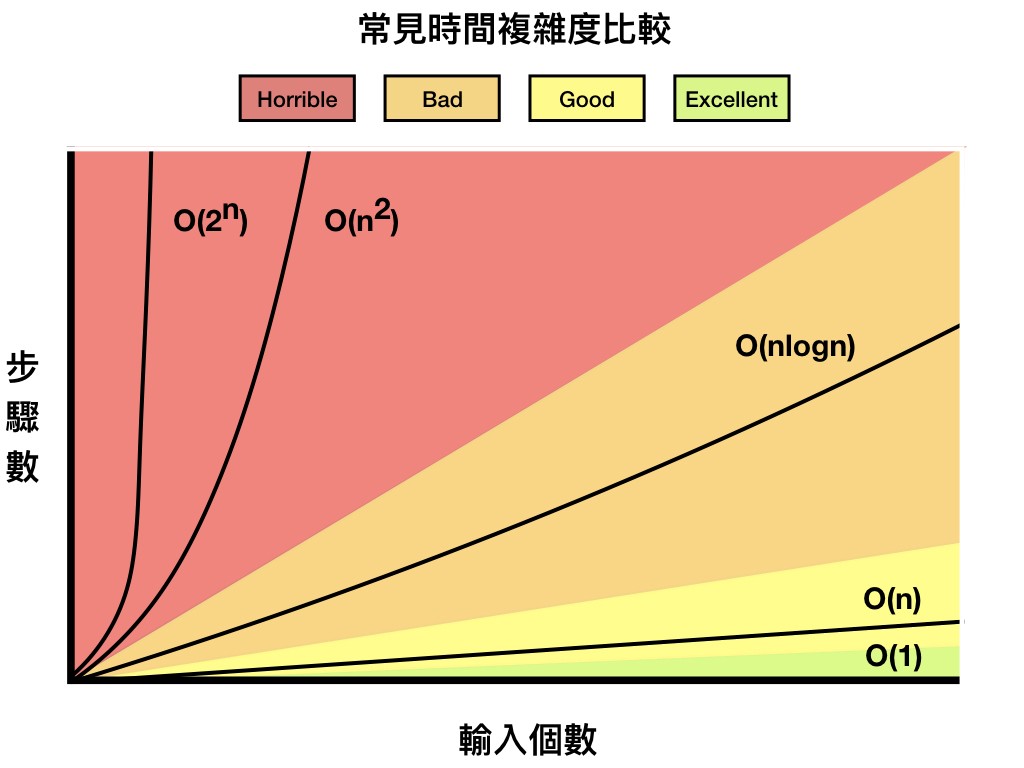[用JS來寫演算法和了解資料結構] Day1 演算法的好壞評量標準 Big O
前言
這個系列主要是想自我挑戰30天用學資料結構和演算法。因為不是資訊本科生,對資料結構的理論一知半解,藉由筆記更加深印象。會搭配一個我很喜歡的前端工程師Hannah分享的鐵人賽文章,來做練習。這邊因為是我個人練習學習,順序或時間可能會跟Hannah的文章不一樣。
會使用或參考到的資源:
演算法的好壞評量標準
兩個評量演算法好壞的指標:
- 時間複雜度 (Time complexity)
- 空間複雜度 佔用記憶體空間 (Space complexity)
- 易讀性 (Readable)
時間複雜度 Time complexity
用來評斷演算法執行的快慢,一般用大 O 符號(Big O notation、BigO)來表示,用來描述一個演算法在輸入 n 個東西時,總執行時間與 n 的關係。
舉個例子,來到書店想買一本書XXX,但架子上有大概100本書,兩種找法:
- 一本一本找,若1本花費1分鐘,10本花費10分鐘,100本花費100分鐘,n本花費n分鐘,時間複雜度是Big O(n)
- 直接用電腦根據索引找到書的位置,不管幾本都只花費了1分鐘,時間複雜度是Big O(1)
Big O

圖片來源
時間複雜度 從好到不好
- Constant Time — O(1) - 陣列讀取 (no loops)
- Logarithmic Time — O(log n) - Binary Search 二分搜索
- Linear Time — O(n) - 簡易搜索 (for loops, while loops through n items)
- Linearithmic Time — O(n log n) - 合併排序、快速排序 (usually sorting operations)
- Quadratic Time — O(n^2) (O n squared / power of 2) - 選擇排序、氣泡排序 (every element in a collection needs to be compared to ever other element. Two
nested loops) - Exponential Time — O(2^n) - 費波那契數列 (recursive algorithms that solves a problem of size N)
- Factorial - O(n!) - (you are adding a loop for every element)
Iterating through half a collection is still O(n)
Two separate collections: O(a * b)
越不好代表程式的步驟次數越高,而非執行時間
1個步驟 Big O(1)
1 | x = 10 |
11個步驟(宣吿1次+回圈10次) Big O(n)
1 | x = 10 |
21個步驟(宣吿1次+回圈10次*2次) Big O(n^2)
1 | x = 10 |
Big O(log n)
假設 n 為 81 個,那麼只要 9 個步驟完成,則是Big O(log n),例子是二分搜索binary search。
時間限制 Time limit
- n <= 1 000 000, the expected time complexity is O(n) or O(n log n)
- n <= 10 000, the expected time complexity is O(n^2)
- n <= 500, the expected time complexity is O(n^3)
重點
- 大 O 符號:用來描述演算法在輸入 n 個東西時,所需時間與 n 的關係
- 演算法的速度不是以時間計算,而是以步驟次數
What Can Cause Time in a Function?
- Operations (+, -, *, /)
- Comparisons (<, >, ==)
- Looping (for, while)
- Outside Function call (function())
Rule Book
Rule 1: Always Worst Case
Rule 2: Remove Constants
Rule 3:
• Different inputs should have different variables: O(a + b)
• A and B arrays nested would be: O(a * b)
+for steps in order*for nested steps
Rule 4: Drop Non-dominant terms
1 | function printAllNumbersThenAllPairSums(numbers) { |
空間複雜度 Space complexity
What Causes Space Complexity?
- Variables
- Data Structures
- Function Call
- Allocations
學習與參考資料
[用JS來寫演算法和了解資料結構] Day1 演算法的好壞評量標準 Big O
![[用JS來寫演算法和了解資料結構] Day1 演算法的好壞評量標準 Big O](/gallery/014.jpeg)